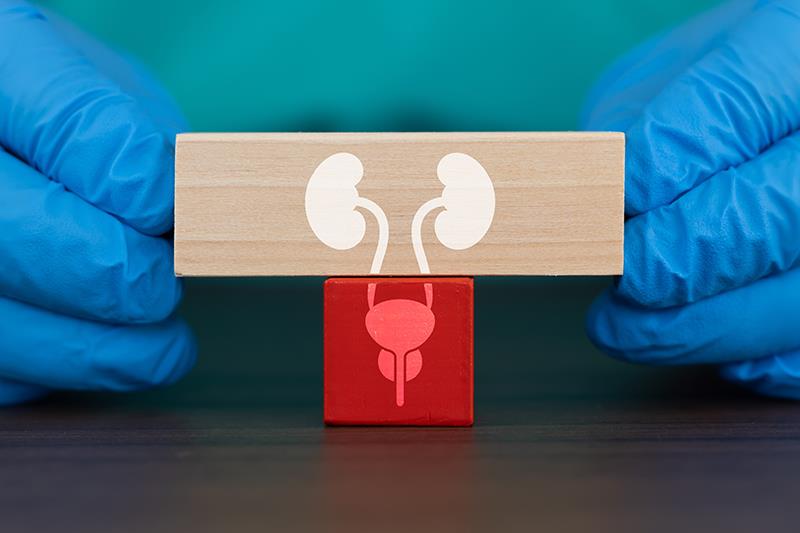HER2-expressing urothelial cancer gets survival boost with disitamab vedotin–toripalimab combo





In the frontline treatment of patients with HER2-expressing locally advanced or metastatic urothelial cancer, the combination of disitamab vedotin plus toripalimab yields a clinically meaningful and significant increase in survival compared with chemotherapy, as shown in the phase III RC48-C016 trial.
Over a median follow-up of 18.2 months, patients treated with disitamab vedotin–toripalimab had a nearly doubled overall survival (OS) compared with those who received chemotherapy, at a median of 31.5 vs 16.9 months. The combination reduced the risk of death by 46 percent (hazard ratio [HR], 0.54, 95 percent confidence interval [CI], 0.41–0.73; p<0.001). [N Engl J Med 2025;doi:10.1056/NEJMoa2511648]
Progression-free survival (PFS) was also significantly longer in the disitamab vedotin–toripalimab vs the chemotherapy arm, at a median of 13.1 vs 6.5 months. This represented a 64-percent reduction in the risk of progression or death (HR, 0.36, 95 percent CI, 0.28–0.46; p<0.001).
These findings “demonstrated for the first time the superiority of an anti-HER2 antibody drug conjugate plus an anti-PD1 inhibitor in a biomarker-selected patient population with locally advanced or metastatic urothelial cancer,” reported principal study investigator Dr Jun Guo from the Peking University Cancer Hospital and Institute in Beijing, China, during a proffered paper session at the ESMO annual meeting.
The OS and PFS advantage with disitamab vedotin–toripalimab were consistent across subgroups defined by HER2 expression levels, visceral metastases status, cisplatin eligibility status, PD-L1 expression levels, and age, among others, Guo added.
The 12-month OS estimates were 79.5 percent with disitamab vedotin–toripalimab and 62.5 percent with chemotherapy. The respective PFS estimates were 54.5 percent and 16.2 percent.
Tumour response and safety
Objective response occurred in 76.1 percent of patients in the disitamab vedotin‒toripalimab arm and 50.2 percent in the chemotherapy arm, with most achieving a partial response. Response duration increased from a median of 5.6 months with chemotherapy to 14.6 months with the combination.
Fewer patients in the disitamab vedotin–toripalimab arm than the chemotherapy arm received subsequent anticancer therapies (31.7 percent vs 67.2 percent). The most common systemic therapies used were pyrimidine analogues (20.6 percent), platinum-based agents (20.2 percent), and PD-1 or PD-L1 inhibitors (10.7 percent) in the combination arm; and PD-1 or PD-L1 inhibitors (50.2 percent) and anti-HER2 inhibitors (40.2 percent) in the chemotherapy arm.
“The safety profile of disitamab vedotin plus toripalimab was consistent with that of each agent and more favourable than that of chemotherapy,” noted Guo.
Grade ≥3 treatment-related adverse events (TRAEs) occurred in 55.1 percent of patients treated with disitamab vedotin–toripalimab and 86.9 percent of those who received chemotherapy. The most common were increased gamma-glutamyltransferase, decreased neutrophil count, hypokalemia, increased lipase, hypoesthesia, hypertriglyceridemia, and peripheral neuropathy in the combination arm; and decreased neutrophil count, decreased white blood cell count, decreased platelet count, and anaemia in the chemotherapy arm. TRAEs led to treatment discontinuation in 12.3 percent and 10.4 percent of patients in the combination and chemotherapy arms, respectively.
Immune-related adverse events occurred in 46.9 percent of patients in the combination arm and none in the chemotherapy arm.
Some considerations
The positive data from the RC48-C016 trial are in line with the those previously reported in the phase III EV-302/KEYNOTE-A39 trial of enfortumab vedotin plus pembrolizumab and “position the regimen with disitamab vedotin as a highly promising option with the potential to change clinical practice,” according to study discussant Prof Andrea Necchi from Vita-Salute San Raffaele University in Milan, Italy.
Nevertheless, Necchi highlighted several limitations in RC48-C016 that should be considered.
“Firstly, the [trial] was conducted exclusively in a Chinese population, implying that further similar studies involving a wider range of race and ethnicities by covering a broader spectrum of geographical areas are needed,” he said.
Necchi also noted that platinum-based chemotherapy, the comparator used in the trial, is already outdated in countries where the combination of enfortumab plus pembrolizumab is available and reimbursed.
RC48-C016 trial
The trial included 484 treatment-naïve Chinese patients with locally advanced or metastatic urothelial cancer, central lab-confirmed HER2 expression, and ECOG performance status of 0 or 1. These patients were randomly assigned to receive treatment with disitamab vedotin–toripalimab (n=243; median age 66 years, 72.4 percent male, 77.4 percent had HER2 IHC score of 2+ or 3+) or chemotherapy (n=241; median age 67 years, 69.7 percent male, 78 percent had HER2 IHC score of 2+ or 3+).
Disitamab vedotin was given at a dose of 2 mg per kilogram of body weight, while toripalimab was administered at a dose of 3 mg per kilogram once every 2 weeks. The chemotherapy regimen consisted of gemcitabine at a dose of 1,000 mg per square meter of body-surface area on days 1 and 8 of each 3-week cycle plus either cisplatin at a dose of 70 mg per square meter or carboplatin at a dose equivalent to an area under the concentration–time curve of 4.5 mg per mL/min intravenously on day 1 of each 3-week cycle. Split doses of cisplatin (administered on days 1 and 2 or on days 1, 2, and 3) were allowed according to clinical practice.
The dual primary endpoints of OS and PFS were assessed by blinded independent review according to Response Evaluation Criteria in Solid Tumors, version 1.1.